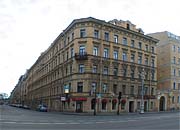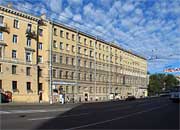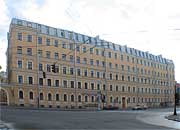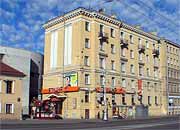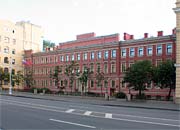Nevsky Prospekt
St. Petersburg
Nevsky's Photographs
Stary (old) Nevsky or Staro-Nevsky Officially still Nevsky Prospekt, this section between Ploshchad Vosstaniya and the Lavra is known as Old Nevsky. Some building numbers are now not used. i.e. 133, 138, 167, etc. whilst other numbers have been allocated to buildings off the street. Staro-Nevsky is predominantly a residential street, littered with 'fashion outlets'. |
Go to main Nevsky Northside |
Photographs © N. Harvey, 1999-2012
If you wish to use one of these images, feel free to do so, however please
contact [email protected] out of courtesy.
Click on the thumbnail to see the full photo.
 |
Number 85 Nevsky Prospekt
is the Moscow Railway station and it fills one side of Ploshchad
Vosstaniya (Uprising Square). Trains have been running between here
and an identical building in Moscow since 1851.
Built by Konstantin Ton, the façade is shown in the midday
sunlight undergoing restoration and transformation from green to a
peachy beige color which allegedly is the original color. (Ton
also built Moscow's Great
Kremlin Palace and the largest church in Russia, the Cathedral
of Christ the Savior on the left bank of the Moscow river) |
|
 |
Number 87/2, acting as a plinth for an obtrusive video screen larger than many people's homes. |
|
 |
Number 87A, has the Alfa Bank on the
left of the ground floor, a Yarky Mir professional photo store on the right and a 24
hour coffee shop in the basement. |
|
 |
Number 89, looking distinctly out of place even in this less affluent half of the street. This exceptionally low building is an annex to the building on the right and currently being used as a warehouse. Maybe it has an interesting history! The future of this building
does not appear healthy during summer 2002, because it is rumored
that a 200 room hotel is going to be built on this site. |
|
 |
Number 89, is no more!
|
|
 |
|
|
 |
Number 91, built 1846-50 in Eclectic style
as a police house by T. F. Krasnopevkov
& V. Beretta, it is now hosting the 'Nevsky
91' mini-hotel. Fully operational from May 2003. (Currently awaiting
more information from the management, but it appears that it will not appear as promised. The block also houses Transportnaya
Knigi (transport books) and Caesar Cosmetics. |
|
 |
Number
93, showing several apartments for sale, with the 'Greenwich' watch
store and the Blinniy Club 'Teremok' on the first floor. |
|
 |
Number
95, is an angular structure known as the house of G. G. Gessel;
it was built in 1912 by architect L . M. Kharlamov in Modern style. The Bistro
Garcon is currently located here and offers a menu of French cuisine
with numerous Bordeaux wines. Open from 9 a.m. to 1 a.m. |
|
 |
Number 97, built in the style of Eclecticsm 1874-75 by M. F. Peterson. Seen here it has 'Zolotoy Zamok' (Golden
Castle) leather goods and the Rossijski Kapital Bank on the first
floor. |
|
 |
Number 99 - 101: Built in the style of Russian Retrospectivism by the architects Kuskov and Lahtman as recently as 1996, as the Central Office of the Leningrad Oblast Sberbank (Savings Bank) of Russia. Sberbank was the only
bank which operated during Soviet time in Russia. It is still state
property and people consider it is reliable. Moreover there are
offices of this bank everywhere in Russia. Be preapared for bad
service and lines. |
|
 |
Number
103, an Eclecticism structure built around 1880 by I. Bulanov, has the French Bakery Boulangerie Francais on the left of the first floor. The top floor (no elevator) has
a 'Rinaldi' mini-Hotel furnished in IKEA-style at mid ranged
prices
to suit affluent tourists. |
|
 |
Number
105: Similarly to the building on the right, the first floor of
this
historic building also has one of the growing number of Rinaldi
mini hotels. Baltinvestbank is also based in this building. It was designed in Eclecticism style by V. A. Flight and completed in 1882. |
|
 |
Number
107: This building which has a confusing mixture of styles from
different eras was originally built around 1910. The last major changes
to the structure were in the Stalinist Neoclassic style by architects
V. F. Belov and E. M. Lavrovsky in 1952. |
|
 |
Number
109: There are two retail outlets on the ground floor of this otherwise
uniformed residential block; the Dom Mod boutique and Adlum (foto.ru)
|
|
 |
Number
111: built in the early 1860's and having a drug store on the corner, a boutique 'N5' in the middle
of the Nevsky facade and a Dom Laverna DIY store on the
right of it. The first floor along the Poltavskaya ul. side street
has a large DIY window retailer. |
|
 |
Number 113 occupies a whole block. Most of the first floor lay empty during 2008. |
|
 |
Number
115: 'Diana' Gallesi boutique has taken over the retail
area on the first floor which for many years was the domain
of the Saxoniya Restaurant. |
|
 |
Number
117: according to the 'Master' signs above the business seen on
the left of the first floor, this building has roof, windows and
doors! On the right is a Swiss watch service center. |
|
 |
Numbers
119-121 on the same lot. It was completed in this Eclecticism style in 1900
by P. Giliyov. |
|
 |
Number
120, is the first building on the south side of 'old' Nevsky. This
façade of the building faces the square opposite the Ploshchad
Vosstaniya Metro station. It was built around 1868 by A. Klimov. Numerous
commercial enterprises are located here, including the Warsteiner Forum
Restaurant (International cuisine & club), and the "Al-shark" bistro. |
|
 |
Number
122: Several retail businesses here, including Na Staronevskom
Antiques, old books, icons, paintings, porcelain. Also furniture,
jewellry, bronze, clocks, old artistic postcards. Sadly, this business
was found closed in November 2008. A small shoe stores remains open
on the ground floor and a small but interesting collection of souvenirs
for sale including Matrioshki. |
|
 |
Number
123: Where on the ground floor the La Perla Boutique has moved to
upper Nevsky and been replaced with a tasteless 'Charme' boutique. |
|
 |
Number
124: was designed by F. N. Sobolewsky, built in 1890 and for many years now,
the end of this building has been known
for advertising and selling Monarch shoes. |
|
 |
Number
125: now has a 'girlie bar' on the left of the ground floor
and a Robert Clergerie shoes outlet on the right. |
|
 |
Number
126: Photographed here in the gloom of a November afternoon
2008, with a relatively modern modification to the corner of
this building and the side which faces onto Suvorovsky
Prospekt. The Rudolf II Bar and the Gambrinus Restaurant on the 2nd floor
have reputations for attracting many 'New Russians', especially at weekends. |
|
 |
Number
127: has the upper floors used for office space whilst the ground
floor has a cafe. |
|
 |
Number
128: Two of the businesses here in this unremarkable building on
the corner of Suvorovsky Prospekt are Tekhsoyuz (Technical Photography
and supplies) and the "Store" bizarrely selling clothing
which could be picked up from a bazaar for a few Rubles. It appears
that this house would benefit from some cosmetic restoration. |
|
 |
Number
129, where Serruti a mens fashion outlet now occupies
the empty area of the ground floor seen in this photo. (a store
called Verol selling furs used to be here for many
years). A tobacconist's store is on the right. |
|
 |
Number 130,
which is currently home to "Charovnitza" a women's
underwear and bathing suits store, an Inkas Bank and an "Ideal
Cup" (Idealnaya Chashka) inexpensive coffee shop which is open
from 7 in the morning until 11 at night. |
|
 |
Number
131, currently has a bank and a café on the ground floor with
apartments above. (there is no number
133) |
|
 |
Number 132, built in a very ornate Renaissance by architect A. Klimov and dates from the years 1877 to 1881. Seen here in 2006 It looks as if the store on the left is being refitted for yet another fashion outlet, whilst there is a cost café on the right of the first floor. |
|
 |
Number
134, where on the left is an outlet for Tervolina footwear, a
Russian manufacturer based in Moscow. On the right of this Eclectic building
is yet another bank. The structure dates from 1898 - architect M. A. Andreev |
|
 |
Number
135, is a relatively modern building complex, hidden away from
the street and behind house number 137. |
|
 |
Number
136 on a double sized lot with no number 138, photographed the day after scaffolding
was removed in November 2008, following cosmetic enhancement
to the facade. |
|
 |
Number
137, is a huge Modern building covering two lots and is a 21st century
construction which appeared during 2003/04. |
|
 |
Number 139, built by
architect E. V. Goldberg in 1879 and where two outstanding contributors
to the arts spent their childhood years: local composer Vasily Solovyov-Sedoy
[1907-1979] (of Moscow Nights fame) and actor Alexander Borisov. Both of them
were friends of Yevgeni Nikolayev, son of General Alexander Nikolayev,
a hero of the Russo-Japanese war of 1904-05, who lived on the first
floor of this building. After the revolution General Nikolayev became
a Red Army commander. During the civil war he was taken prisoner,
refused to renounce his convictions, and was publicly hanged by the
White Guards. |
|
 |
Number
140, an otherwise unremarkable turn of the century building
has a corner tower which catches the eye. The ornate corner piece and
dome did not appear until after WWII. This building was designed
in the Eclecticism style by the architect Alexander Sergeievich
Khrenov and built during 1901/02. |
|
 |
Number
142, is somewhat of an oddball as it was built at a right angle
to Nevsky. The street on the left is Degtyarnaya Ulitsa and the
street on the right is Prospekt Bakunina. The street light seen
in front of the building is on Nevsky Prospekt. |
|
 |
Number 142 again, showing the side facing Prospekt Bakunina. The Academic Gymnasium was the first to be opened in St. Petersburg in this building(1726-1805). One of the largest gymnasiums in the capital was later opened here in 1889 by A. P. Nikiforova. (GYMNASIA, institutions of intermediate general education. In pre-revolutionary Russia they were mainly established with the purpose of training pupils for university and service in state institutions.) Two mini-hotels have recently opened at this location: the' Filippov' and the
'Style'. |
|
 |
Numbers
141 to 145: This block is a rare example of Stalinist Constructivism
in Nevsky's architecture. It replaced an 1883 building and was designed
by Alexander Lvovich Lishnevsky and completed in 1936. |
|
 |
Numbers
144 and 146 integral on the same triangular lot. 144 nearest
the camera, has for many years housed L'Etoile perfumes & cosmetics.
This monument to Constructivism replaced two 1883 buildings in 1933 and
was designed by V. F. von Haecker. |
|
 |
Number 146; housed Dom Laverna, a household goods store for many years until 2008. On the left, it is just possible to see where number 144 joins the bridge of the center section. |
|
 |
Number
147, was built 1905-1906 to the designs of architect Pavel Batuyev.
It was reconstructed in 2004 to modernize the entrance and provide
16 double rooms for the new mini Hotel Stary Nevsky (The Old
Nevsky
Hotel). Yet another mini jumping on the hotel bandwagon is the
Royal Antares Hotel also located in this building. Five fashion
outlets have premises in this building: Simona, Studio S,
Skandia, Freelance and Pierre Cavallo. There is
also a store called Louis which sells men's
and women's leather clothing from Italy. |
|
 |
Number 150, has its fair share of modern apartments above the first floor where the Gondola café was a popular venue until late 2006. This café was bought out and replaced with a 'fashion outlet; a fate that befell several other businesses as they struggled to compete with the rising proprty rates. 'Nevsky 150' mini hotel opened in this building in January 2004. The building was erected
during 1880 by architect F. F. Soloviev. In 1934 it was designated as a cooperative
for the families of Leningrad's Soviet Engineers. |
|
 |
Number 151, is home to Katrin/ BGN and Russki Lion fashions.
|
|
 |
Number
152, is the second newest (part-residential) building on Old Nevsky, built towards the end
of 2006 by A. M. Gerasimov & Partners and seen here in November 2008. |
|
 |
Number
153: Architect of this apartment building in the early 1900s was Lev Petrovich Shyzko who was
also official architect to the Alexander Nevsky Lavra, and built the New Vestry there.
|
|
 |
Number
154, photographed whilst number 152 was being built. The main businesses
here in 2008 are a branch of the men's fashion house, Cashmere
& Silk and Bally, which is an upmarket fashion accessories
store. A purse (sumka) could set you back $2000.
|
|
 |
Number
156, houses a Charles Jordan outlet. |
|
 |
Number 158, mainly residential having at least four separate stores on the first floor. This stately mansion on the corner of ul. Aleksandra Nevskogo was built in 1874 in the Eclecticism style by architect I. Bulanov. |
|
 |
Number
160, is mainly residential with a porcelain store on the first floor.
On the right of this there is the cafe-bar ‘Ketaiski Gorodovoy’
(Chinese Policeman), where Chinese style food can be eaten along
with a decent selection of wine. It was erected in 1880, architect G. A. Solovev. |
|
 |
Number 162: currently
houses one of several 'Phototechnica' outlets in the city. |
|
 |
Number 163: has the
'Rasputin' bar and restaurant on the first floor. The building
also has 'Stoma'
offices and dental surgeries located on the first floor. This plot
is between number 169 on the left and 155 on the right. |
|
 |
Number 164: is yet another
mainly residential house with on the left of the first floor, an
outlet for Roberto Bottecelli. They claim to be an international
chain of quality designer shops for young men's shoes. Maybe when
they get a web-site, they will begin to attract some business and
acclaim in Russia. |
|
 |
Number 166: has "elena
miro" showing on the left of the first floor during 2008. This
is a fashion house which caters for the 'large woman'. On the right can be
seen the café-bar called "Lesnoy" (meaning 'forest') which is a popular venue
on warm summer evenings. The building also houses the "Palitra National Center".
Individual and group exhibitions of works by contemporary artists are held here every
month at this gallery which is one of the best-known exhibition centers in St.
Petersburg for painting, graphic art and sculpture. Open TUE-FRI
11 a.m. to 7 p.m., SAT noon to 6 p.m. |
|
 |
Number 168: an ornate
and impressive building designed with a more Eastern flavor than
most in St. Peterburg. "Incanto" which is a rapidly expanding
chain of women's underwear shops, have an outlet here. This is only
one of several in the city and Incanto have stores in eight other
Russian cities selling stylish garments to the 'New Russians' who
have money to burn. |
|
 |
Number 169: This is
a wholly residential building set back from the street and erected
during Soviet times. A small section of it appears to be
used as
a school. |
|
 |
Number 170 is one of two similar buildings that have
copper domes as a showpiece on Old Nevsky. |
|
Number
172: corner cafe ‘U Sergeya’ (At Sergei’s), house.
Their menu is cosmopolitan, service is friendly and the average
bill is less than 200 rubles per head as we enter 2006. |
||
Number
173, has yet another bank (Petro Bank), Xerox Center, and the Liberty
Russia International Tourism Group, to name but a few businesses
here. |
||
Number
174, is known for being the home of 'Porto' a Maltese restaurant,
although this is one of the largest apartment blocks on Old Nevsky. |
||
Number
175, where a Sushi restaurant and a photographic store trade
from this prominent site. |
||
Number
176, hosts the California Grill & the very expensive Kolhida(Georgian)
Restaurant. |
||
 |
Number 177, The last
building on this south side of the street, before Ploschad Alexandra Nevskogo.
|
|
 |
Number
178, the Sankt Peterburg Bank. Built in 1845 according to the Neo-Classicism
designs of K. I. Brandt as a spiritual consistory, but reconstructed since. |
|
 |
Number
180, another mainly residential building, neat but unremarkable. |
|
 |
Number
182, where there is the chain restaurant ‘Il Patio’,
often with summer tables outside. In the basement, there is the
cafe ‘Chesnochok’. Over its entrance there is a sign
reassuring you with the honesty of the place. However the staff
easily lose their manners which does not help this establishment
become a popular venue. |
|
 |
Number 184,
The last of the tall buildings on the north
side of the street before Ploschad Alexsandra Nevskogo. (The adjacent
smaller building on the right is No.190 - Russian logic!) |
|
 |
Number 190, is the ancient
two story building now being dwarfed by the enormous roomy but gloomy Hotel Moscow which
was built by the Soviets in the 1970's. The onlookers seen in
this view are admiring the new monument to Alexander Nevsky which had just been
unveiled off picture to the right . (Which can be seen on a
separate page by clicking here.) |
|
 |
Sometimes called Dom Ugly, the huge Hotel Moscow which fills one side of the square was opened in 1976. It has 7 floors with 777 recently refurbished rooms and another floor of rooms is planned. The festive New Year plinth seen here in January 1995 had been temporally abandoned on the spot where the new equestrian Alexander Nevsky monument has been sited since May 2002. |
|
 |
Yes. This is the same
building as in the previous photo, captured here in the gloom
of November 2008. The hotel does not now look so gloomy from
the outside, having had extensive cosmetic surgery
and another floor added. Inside there have been improvements too,
however the gloomy management were not keen for me to take any
internal photographs. |
|
 |
The same location before the monster was born c1950 |
|
 |
Nevsky's Lavra. The
northwestern tower (Riznica) of the St.
Alexander Nevsky Lavra (Lavra = highest rank Monastery).
|
|
 |
Nevsky's Lavra 2. A closer view of the Petrine Baroque styled Church
of the Annunciation at the Lavra. |
|
 |
Nevsky's Lavra 3. A
sign for the tourists outside the entrance to the Tikhvin cemetery,
which is on the right of the main path entering the monastery. This
is quite an impressive role of current residents and note that Pushkin's
wife is listed under the name of her second husband Lanskaya. |
|
 |
Nevsky's Lavra 4. The Neoclassical Holy Trinity Cathedral (c1776-90, architect Ivan Starov) contrasts awkwardly with the elaborate Baroque treatment applied to the façades of the monastery's other buildings. The inside of this working church is well worth viewing and has murals painted by N. Akimov and other illustrious artists. Behind the cathedral is another cemetery containing the graves of twenty monks of the monastery who were martyred right there by the communists, shot in front of a wall, which still bears the many bullet holes. |
|
 |
The Alexander Nevsky Bridge (Most), was built between 1960 and 1965 to solve a major transport problem. Effectively, the bridge links the Alexander Nevsky square with Zanevsky Prospekt in the outlying Malaya Okhta district where these days, most of the city's residents live in bedroom communities. The bridge is the longest of 342 bridges inside the city limits with a length of 905.7 meters and it is 35 meters wide. The Bridge also boasts several innovations, including iron-and-concrete support shells, improved beam span support, and eight-sided columns for stronger bank abutment. The bridge's railings, lamps and other features are otherwise in a strictly functional, modern style. It is one of 22 drawbridges in the city and has seven bridge spans with the central span capable of being fully drawn in two minutes. |
| Links to other quality image
sites in Spb;
CityScan by Cameraman |
Last updated December
20th 2013 |
